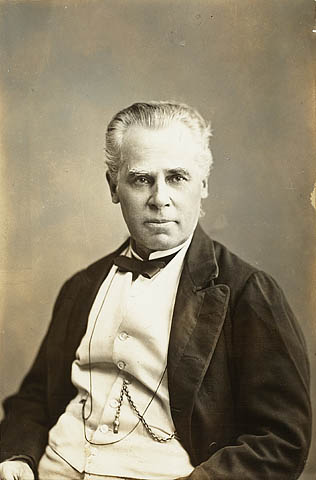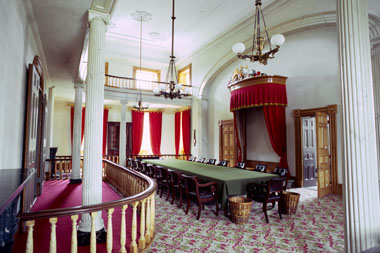In the early 1860s, politics in the Province of Canada were unstable and deadlocked. The Great Coalition of 1864 was a turning point in Canadian history. It broke the logjam and helped to create a new country. It united Reformers and Conservatives in the cause of constitutional reform. This paved the way for the Charlottetown Conference and Confederation.
This article is a plain-language summary of the Great Coalition of 1864. If you would like to read about this topic in more depth, please see our full-length entry: Great Coalition of 1864.
![The province of Canada [cartographic material] The province of Canada [cartographic material]](https://d3d0lqu00lnqvz.cloudfront.net/media/media/bf6a8447-8306-4749-bb63-2f6129eb20a6.jpg)
Political Change and Population Growth
In the early 1860s, Canadian politics were in a state of crisis. In 1841, Upper and Lower Canada were united into the Province of Canada. (See Act of Union.) It was made up of the largely English-speaking Canada West (Upper Canada) and the mostly French-speaking Canada East (Lower Canada). But the union had failed to stop growing ethnic and religious tensions. The political system was becoming deadlocked.
Canada West and Canada East were given the same number of seats in the new legislature. But Canada West had fewer people than Canada East. This meant English-speaking Canadians were over-represented. The system was meant to protect anglophones. The goal was to assimilate French Canadians to English culture and norms.
In the 1840s and 1850s, immigration from Britain and Ireland increased. This led to a huge population growth in Canada West. By 1861, the West had 250,000 more people than the East. Now, French Canadians were over-represented. A growing number of English Canadians saw this as unfair.
Alliances and Tensions
French Canadian politicians wanted to protect their language, culture and religion. They teamed up with those in Canada West who wanted responsible government. It was a more democratic system. It gave power to the elected assembly rather than to governors who were appointed by Britain.
In Canada East, French Canadian conservatives had much political power. They had close ties to the Catholic Church. In the 1850s, French Canadian leaders teamed up with Conservatives in Canada West. This gave them much control over the levers of power. They had turned a system that was meant to assimilate them to their advantage.
But a growing number of people in Canada West saw this as “French domination.” As this view spread, Liberals, Reformers and Radicals (also called Clear Grits) became more popular in Canada West. Many were hostile toward Catholicism.
In the early 1860s, there was a Liberal-Reform majority in Canada West. There was a Conservative majority in Canada East. As a result, the province became unstable. It lurched from one messy government to another. The political climate was one of resentment and fear.

Rep by Pop
One fix was to adopt a system of representation by population. This idea was put forth by George Brown. He was the powerful Reform Party leader in Canada West. He was also in charge of the Globe newspaper. Under a “rep by pop” system, all voters would be treated equally. Where they lived or what language they spoke would not matter. Governments would reflect the wishes of most voters in the whole province.
But this was unacceptable to many French Canadians. Many thought rep by pop would reduce them to a minority. This could have a dire effect on their religion, language and culture. The Reformers in Canada West insisted on personal rights. But this conflicted with French Canadians’ desire to protect their rights.
Other Options
Another fix appealed to many Radicals (Clear Grits) in Canada West. It was to dissolve the union. English Canadians in Canada West could control their own affairs. French Canadians in Canada East could control theirs. But this would make English-speakers in Canada East and Irish Catholics in Canada West vulnerable. There was also the chance that ending the union would make the new provinces easier to annex into the United States. Britain opposed anything that might weaken its North American empire. British opposition to ending the union would be hard to overcome.
A third option was to govern the province based on a “double majority.” This meant laws would need to have majority support in both Canada West and Canada East. But this would only work if each region elected like-minded majorities. That was highly unlikely.
George Brown's Federalism
George Brown was drawn to the idea of a federation of Canada East and Canada West. This would mean creating two separate provinces. They would have a new federal parliament. Brown also wanted to include Rupert’s Land. It was controlled at the time by the Hudson’s Bay Company.
In 1860, Brown introduced the idea in the Province of Canada legislature. He got nowhere. His proposals were soundly refused. In fact, they nearly split his own party. Most French Canadian politicians saw no reason to change the status quo. This was because it gave them the power they wanted. John A. Macdonald's Liberal-Conservative coalition in Canada West was still allied with Conservative majorities in Canada East. So long as that was the case, Macdonald's supporters would be part of the government even if they were a minority in Canada West.
In 1860, a federal union seemed dead in the water.

Toward the Great Coalition
Four years later, Reformers and Liberal-Conservatives in Canada West were working with the Patri bleu in Canada East. They all wanted Confederation. It was one of the most rapid turnarounds in the history of Canadian politics. How did it happen?
It was due in part to outside events. The biggest factor was the start of the American Civil War in April 1861. As the war went on, the Union army grew larger. Tensions between the US and Britain threatened to make the war bigger. It came close to happening in the winter of 1861–62. Canada could not stand up to the US without British support. But Britain thought Canada should play a larger role in defending itself. It felt that a united British North America would be able to do this. It would be much harder for a string of colonies.
At the same time, Canadians struggled to form lasting governments. From 1861 to 1864, there were two elections and a string of weak governments. The political system needed to change.
Meetings in the “Spirit of Compromise”
George Brown felt that drastic action was needed. In October 1863, he proposed an all-party committee to discuss Canada’s future. Everything would be on the table. The idea was to have an open, non-partisan talk. The goal was to break the logjam of Canadian politics.
Brown brought his proposal to the government in May 1864. The Liberal-Conservative government was barely clinging to power. Conservative leaders John A. Macdonald and George-Étienne Cartier were against Brown’s idea. So were Reformers such as Luther Holton and Antoine-Aimé Dorion. But both the Conservative and Reform rank and file were divided on the issue. The resolution got enough support to pass. This surprised Macdonald and Cartier.

Brown appointed a committee with members from both parties. The goal was to discuss constitutional reform. At the first meeting, he locked the door and put the key in his pocket. “Now gentlemen,” he said, “you must talk about this matter, as you cannot leave this room without coming to me.” And so, 17 men, some of whom could not stand one another, were trapped in a room. They were forced to find a way out of Canada’s problems. In Brown’s words, they approached their work “frankly and in a spirit of compromise.” This was done despite their differences.
In eight meetings, they talked about the merits and drawbacks of rep-by-pop. They talked about ending the union. They talked about the double majority, federalism, and keeping the status quo. They seemed to be moving in favour of a federation.
On 14 June 1864, the Liberal-Conservative government lost in the House on an unrelated non-confidence motion. This would mean yet another election. It would likely mean yet another unstable government.
A New Alliance
Then something surprising happened. George Brown felt the crisis offered a chance to break the logjam. John A. Macdonald felt that an alliance with Brown could open up all kinds of options. The two men had a brief meeting on 16 June 1864. Then the talks began.
In the meetings, the Liberal-Conservatives wanted Brown and his Reformers to be part of a governing coalition. The Liberal-Conservatives thought that Brown and his supporters would be easier to control if Brown was in the cabinet. Brown didn’t really want to join with his old enemies. But he came under pressure from the Conservatives and his own supporters. They argued that he could influence events from a position of power. Brown didn’t want the talks to break down. So, he chose to bring his party into the government.

Toward Confederation
There was one other main question. Should a federal solution apply only to the Province of Canada? Or to British North America in general? Brown wanted federalism for Canada alone. This would leave the Reformers in control of Canada West. A wider solution could hurt the task of dealing with the Canadas’ political crisis.
John A. Macdonald had never liked the idea of a federation of only the two Canadas. He also thought a united BNA could counter the expansion of the United States. (See Manifest Destiny.) It could also make the Conservative base bigger by bringing in the Maritimes.
After four days of talks, an agreement was reached. A bill would be tabled in the next session of parliament for federalism among the Canadas. At the same time, the coalition government would explore a wider federation in British North America.
Charlottetown Conference
The Great Coalition was formed in late June 1864. That same week, the Governor General of the Province of Canada, Lord Monck, wrote to his counterpart in Nova Scotia. He asked that a Canadian group attend a meeting on Maritime union. It was being planned in Prince Edward Island. The request was accepted.
Members of the Great Coalition joined the Charlottetown Conference in September 1864. Thomas D’Arcy McGee called it an “extraordinary armistice in party warfare.” The Great Coalition was a turning point in Canadian history. It broke the logjam of central Canadian politics. It paved the way for Confederation in 1867.
See also Responsible Government (Plain-Language Summary); Province of Canada (Plain-Language Summary); Act of Union (Plain-Language Summary); Charlottetown Conference (Plain-Language Summary); Confederation (Plain-Language Summary).

 Share on Facebook
Share on Facebook Share on X
Share on X Share by Email
Share by Email Share on Google Classroom
Share on Google Classroom






